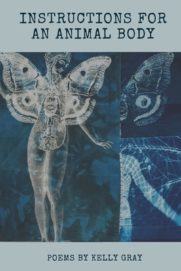 Kelly Gray
Kelly Gray
Moon Tide Press ($15)
by Ralph Pennel
In every Yorgos Lanthimos film, the characters are always simultaneously in translation and untranslatable. Their bodies, their identities are in flux, but it is in their routines of just being that their beingness becomes differentiated, emergent. In the poetry collection Instructions for an Animal Body, Kelly Gray explores these same themes of illimitability in stasis, with each poem, each line, each turn of the page an exploration toward a better, broader understanding of how a self is constructed.
Instructions for an Animal Body is syllabus, it is conspectus, but it is inconclusive disquisition, too. At every turn, it is in process, on process, the process. From the very start we find the speaker of each poem dreaming and shapeshifting, excavating the actual and virtual realms. In the poem “The Fox as Form,” the speaker is donning a fox skin; in “The Fish as Healer,” the speaker can no longer tell where they end and a fish begins. In “The Places Inside Me,” they are “so fucking dead it makes [them] alive,” until the borders between self and other have also become part of the speaker’s emerging beingness.
In the poem “I-395,” Gray’s exploration of actuality and virtuality continues. The poem opens, as every creation myth does, by attempting to name the unnamable:
In the beginning, there was only you
and your knife. You start by carving out a landscape,a place to hang your words. Chip by chip you design a desert floor
and then, the inverse dome of black sky.
Also like any good creation myth, the story is really about the “landscape” of the speaker’s self, the process of “carving” a being out of clay (or in this case, sand). The “you” is both other and self, “You, the original Storyteller,” who “drive[s] your truck across this world / that she has mistaken for yours.” The difference between translational and untranslatable bodies becomes clearer as this journey progresses.
By the time we reach the poem “Crack Me Electric” (a nod to the Greek figure of Electra), it is clear that the speaker is aware of the emerging, transformative self. We see this awareness right away in the first stanza:
In morning dark, my eyes open to the sound of frothing
sky beasts dragging their tic-bitten bellies
across rooftops and canyons, blast cracking their cloven
hooves against the forest canopy, all wet
snout and bellow.
The speaker has woken from the dream state, and this “awakening” is further illuminated later in the poem, when they claim, “This is how I learn that my internal etymology has shaped my / adaptations / from insect to monster.” Here the speaker acknowledges the articulating, emergent, differentiated being and how poetry/poetics are a necessary dialectical tool through which to sense this experience. They may, in fact, be the only tool.
Gray exhibits exploration, excavation, and adaptation throughout Instructions for an Animal Body, but it is perhaps never more apparent than in the poem “Home of Seamstress.” At this point in the text, near the end, the speaker has reached a state of transformation, because they are fully aware of their transformative, ever-constructing identity:
I am lungs of house, a glass-spanned wall hung chandelier of larynx and trachea . . .
. . . . . . . . . . . . . . . . . . . . . . . . . . . . . . . . . . . . . . . . . .
I am mouth of house, tilted bookshelves, titles decorated with bird song. . . .
. . . . . . . . . . . . . . . . . . . . . . . . . . . . . . . . . . . . . . . . . . .
I am hollow of house, needlewoman, double crossed on floor, spilled eyes and fabric scraps . . .
The voice is declarative, effusive. Here, the “seamstress” threads together the disparate, each stitch an adaptation and an enumeration, an assemblage of territories and the practice of deterritorialization. As we bear witness to “home of seamstress” and “seamstress as home,” the untranslatable becomes translation.
Instructions for an Animal Body is itself an animal body; the seams, the cover, the binding that holds the pages together are a construct of an emergent identity. This would be a difficult task by any measure, and it is excellently executed by the author in this engaging, rich collection.
